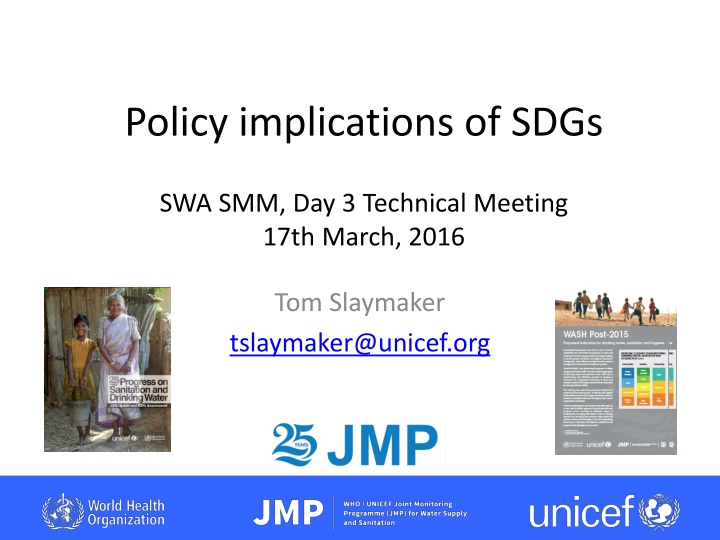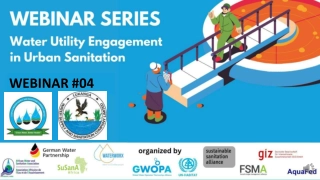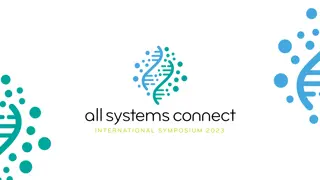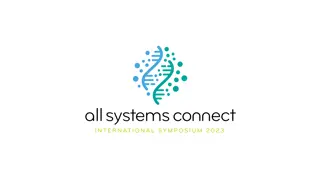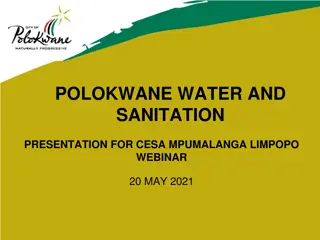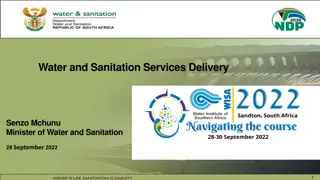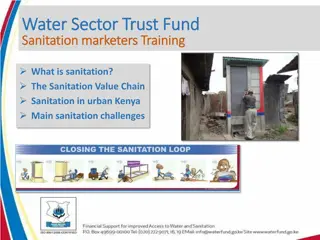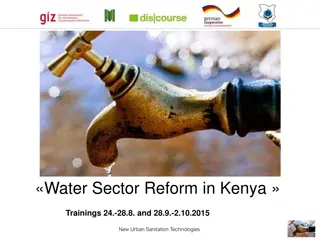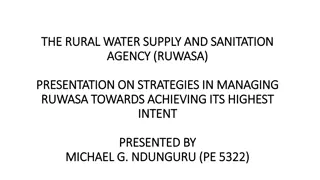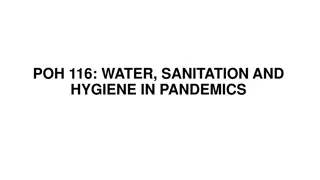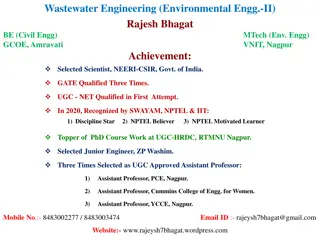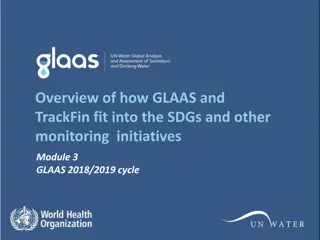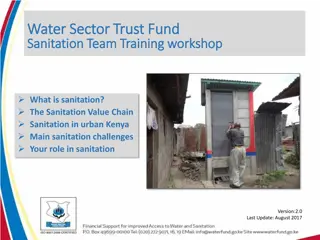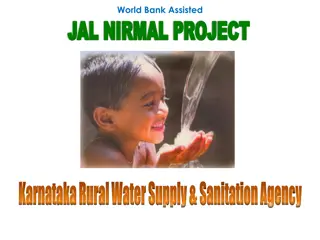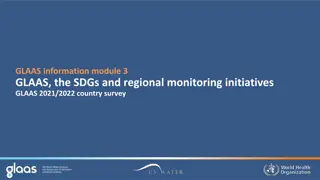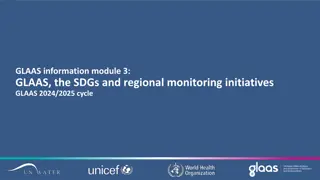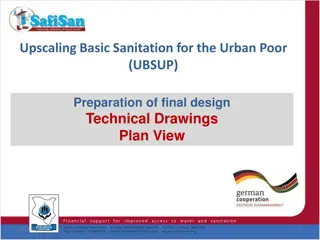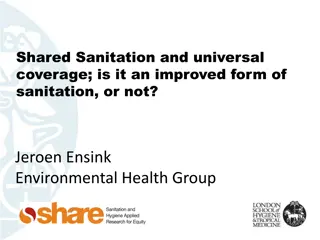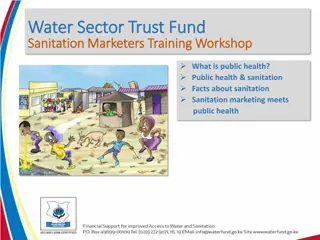Policy Implications of Goal 6: Sustainable Water and Sanitation Management
The Sustainable Development Goals (SDGs) emphasize the importance of ensuring availability and sustainable management of water and sanitation for all. Goal 6 specifically focuses on achieving universal access to safe drinking water and adequate sanitation by 2030. Member states are urged to set national targets and review progress in line with the global ambition of the SDGs. International cooperation, capacity development, and local participation are key components in achieving Goal 6. The integration of SDGs into national planning processes is crucial for promoting sustainable development worldwide.
Download Presentation

Please find below an Image/Link to download the presentation.
The content on the website is provided AS IS for your information and personal use only. It may not be sold, licensed, or shared on other websites without obtaining consent from the author.If you encounter any issues during the download, it is possible that the publisher has removed the file from their server.
You are allowed to download the files provided on this website for personal or commercial use, subject to the condition that they are used lawfully. All files are the property of their respective owners.
The content on the website is provided AS IS for your information and personal use only. It may not be sold, licensed, or shared on other websites without obtaining consent from the author.
E N D
Presentation Transcript
Policy implications of SDGs SWA SMM, Day 3 Technical Meeting 17th March, 2016 Tom Slaymaker tslaymaker@unicef.org
Goal 6: Ensure availability and sustainable management of water and sanitation for all 6.1 Means of Implementation Drinking Water 6.2 6.6 Eco- systems 6.A Sanitation and Hygiene International cooperation and capacity development Goal 6 6.5 Water resource managem ent 6.3 Water quality 6.B Local participation 6.4 Water-use Efficiency
Aspirational global targets 55. The Sustainable Development Goals and targets are integrated and indivisible, global in nature and universally applicable, taking into account different national realities, capacities and levels of development and respecting national policies and priorities. Targets are defined as aspirational and global, with each Government setting its own national targets guided by the global level of ambition but taking into account national circumstances. Each Government will also decide how these aspirational and global targets should be incorporated into national planning processes, policies and strategies. It is important to recognize the link between sustainable development and other relevant ongoing processes in the economic, social and environmental fields. 4
Role of Member States Set national targets, review progress 78. We encourage all Member States to develop as soon as practicable ambitious national responses to the overall implementation of this Agenda. These can support the transition to the Sustainable Development Goals and build on existing planning instruments, such as national development and sustainable development strategies, as appropriate. 79. We also encourage Member States to conduct regular and inclusive reviews of progress at the national and sub-national levels which are country-led and country-driven. Such reviews should draw on contributions from indigenous peoples, civil society, the private sector and other stakeholders, in line with national circumstances, policies and priorities. National parliaments as well as other institutions can also support these processes. 5
Goal 6: Ensure availability and sustainable management of water and sanitation for all Means of Implementation 6.1 Target 6.1: By 2030, achieve universal and equitable access to safe and affordable drinking water for ALL Drinking Water 6.A 6.2 6.6 Eco- systems International cooperation and capacity development Sanitation and Hygiene Target 6.2: By 2030, achieve access to adequate and equitable sanitation and hygiene for ALL, and end open defecation, paying special attention to the needs of women and girls and those in vulnerable situations Goal 6 6.5 Water resource managem ent 6.3 Water quality 6.B Local 6.4 Water- use Efficiency participation
Target 6.1: Drinking water By 2030, achieve universal and equitable access to safe and affordable drinking water for all 6.1.1: Population using safely managed drinking water services Definition: Pop. using an improved drinking water source which is: located on premises, available when needed, and free of faecal and priority chemical contamination Lead: WHO/UNICEF Joint Monitoring Programme Accessibility Availability Quality 7
MDG/SDG Service ladder Progressive realization SDG 6.1 Safely managed drinking water Improved facility located on premises, available when needed, and free from contamination Developing Developed Improved facility within 30 minutes round trip collection time Basic water MDG continuity Unimproved water Unimproved facility does not protect against contamination No service Surface water 8
Where will the data come from? Criterion Household Surveys Regulatory authorities Availability Is water always available when needed from your main drinking water source? Reported hours of service (piped) Accessibility Is the main drinking water source located in the dwelling yard or plot? Reported household connections (piped supplies) Quality Testing for fecal (and chemical) contamination in household surveys Compliance with national standards, WSPs Affordability? 9
Implications for Country X 98 95 100 89 90 80 74 70 58 58 60 50 40 30 20 10 0 Improved (MDG) Basic (<30 mins) Available when needed On premises (accessible) E. coli <1 (quality) Safely managed (SDG) 10
Target 6.2: Sanitation and hygiene By 2030, achieve access to adequate and equitablesanitation and hygiene for all, and end open defecation, paying special attention to the needs of women and girls and those in vulnerable situations 6.2.1: Population using safely managed sanitation services including a handwashing facility with soap and water Definition: Pop. using an improved sanitation facility which is: not shared with other households and where excreta are safely disposed in situ or transported and treated off-site Accessibility Quality 11
MDG/SDG Service ladder Progressive realization SDG 6.2 Private improved facility where faecal wastes are safely disposed on site or transported and treated off-site; plus a handwashing facility with soap and water Developing Developed Safely managed sanitation Improved facility which separates excreta from human contact (private) Basic sanitation MDG continuity Improved facility which separates excreta from human contact (shared with other hh) Shared sanitation Unimproved facility does not separate excreta from human contact Unimproved sanitation Open defecation No service 12
End-use/disposal Emptying Containment Transport Treatment 27% Offsite sanitation Basic sanitation (BAP) 33% Onsite sanitation: 6% Septic tanks, pit latrines, VIPS, and other systems Shared services Unimproved services SDG 6.2 Sanitation Ladder for Peru No sanitation services Safely managed services (SMaSS) 33% Basic services (BSS = BAP - SMaSS) 41% Country Y Shared services (SHS) 9% 41% 6% 11% 9% Unimproved services (USS) 11% No sanitation services (NSS) 6% Source:
Where will the data come from? Household surveys Regulatory authorities Fecal wastes reach a treatment plant and adequately treated before discharge Sewer connections Septic tanks - fecal wastes safely stored on site, or Fecal wastes emptied and treated off-site Latrines fecal wastes safely stored on site, or Fecal wastes emptied and treated off-site
Country Y Latrines Septic tanks Sewered 35 35 33 33 2 83 74 74 65 62 27 27 11 8 4 2 4 7 4 2 0 0 4 Improved + shared Improved Treated offsite Treated onsite Safely managed sanitation services
Target 6.2: Sanitation and hygiene By 2030, achieve access to adequate and equitable sanitation and hygiene for all, and end open defecation, paying special attention to the needs of women and girls and those in vulnerable situations Population using safely managed sanitation services including a handwashing facility with soap and water Standard question in MICS and DHS since 2009 Observation by survey teams Data available from 50+ countries Accessibility Availability 16
SDG targets 'leave no one behind' SDG indicators to be disaggregated where relevant income, sex, age, race, ethnicity, migratory status, disability and geographic location, or other characteristics 17
between urban and rural Population practising open defecation in urban and rural areas, 2012 21
Monitoring 6.3 (WHO, UN-Habitat, UNEP) 6.3.1. Wastewater treatment Ratio: safely treated / total Multi-sectoral Domestic wastewater (sewage + faecal sludge) Drawn from 6.2.1 Hazardous industrial wastes (point sources) Data from: JMP, AQUASTAT, IB-NET (domestic wastewater) National inventories of industries (hazardous wastes) 6.3.2. Ambient Water Quality Key water bodies Water Quality Index Total dissolved solids Dissolved O2 Dissolved inorganic N Dissolved inorganic P E. coli Multiple rungs # of noncompliant parameters, WQ index, more parameters Data from GEMS/Stat (in situ and modeled), OECD, remote sensing 23
Monitoring 6.4 (FAO-AQUASTAT+) 6.4.1* Efficiency Ratio: value added to volume water used Change over 3-5 year period Multi-sectoral Agricultural Industrial Energy Municipal supply Data from AQUASTAT (including national sources), World Energy Outlook, IB-NET 6.4.2* Water stress Ratio: total freshwater withdrawn to total renewable resources Reserving environmental water requirements Multi-sectoral Agricultural Industrial Municipal supply Data from AQUASTAT (including national sources) 24
Monitoring 6.5 and 6.6 (UNEP+) 6.5.1* IWRM implementation Composite indicator Policies Institutions Management tools Financing Equal weighting, score 0-100 Data from national surveys completed by ministries and consultations 6.6.1* Ecosystems Percentage of change in water- related ecosystems extent overtime Wetlands, forests and drylands Wetlands: marshes, fens, swamps, ponds, lakes, rivers, aquifers Extent, (Quantity, Quality, Status) Data from ground data + Earth Observations Reporting on UNEP-Live platform 25
